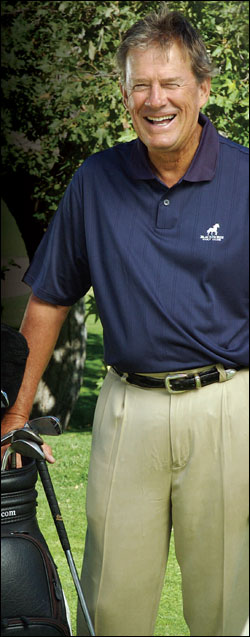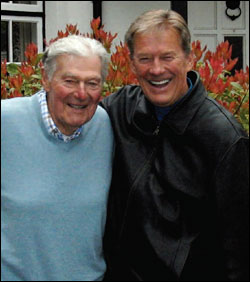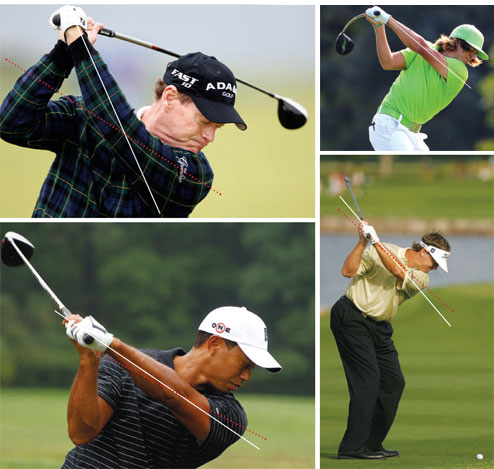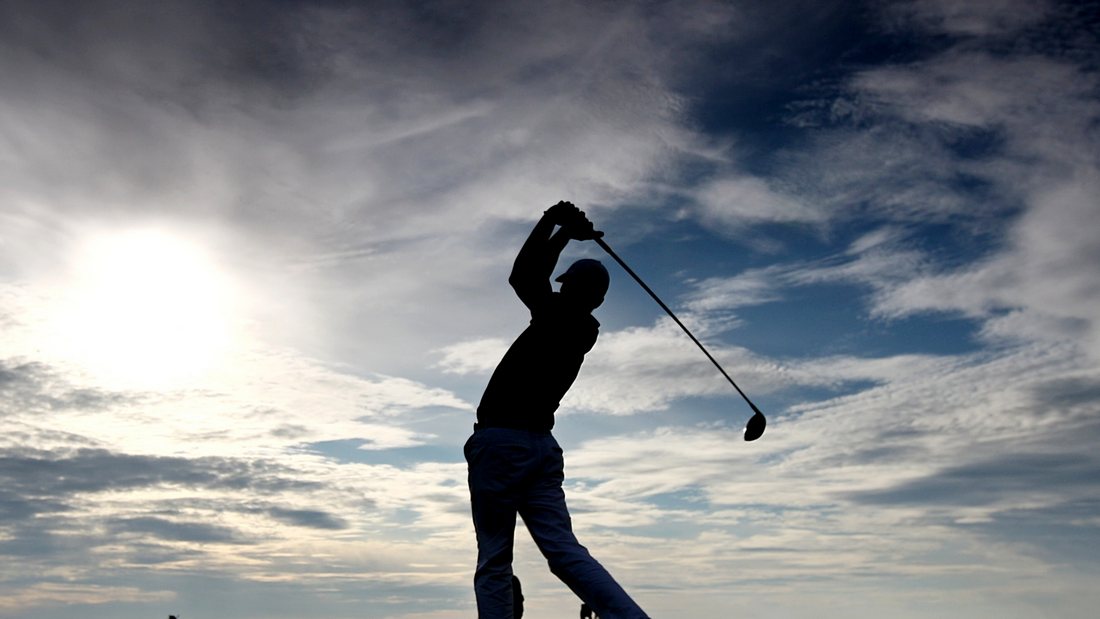Tuition
The Plane Truth
Part 1 - Plane Talk - Interview with golf swing coach Jim Hardy
Revered US coach, best-selling author and all-round golf guru, Jim Hardy has transformed our understanding of the swing plane while developing arguably the world's most comprehensive system for analysing ‘faults and fixes' available through his international network of teaching pros and soon through a remarkable new online venture. Dominic Pedler talks to the visionary instruction expert
Part 1 - Plane Talk - Interview with golf swing coach Jim Hardy
Part 2 - The Matrix & My Profile - A revolutionary vision for online golf instruction
Part 3 - One & Two Plane Golf Swings - A rough guide
Part 4 - Matt Kuchar - Natural Born One Plane Golf Swing
Part 5 - Leading Plane Truth certified pros in the UK give their verdict
Part 6 - In three balls you could cure your slice

JH: It stems from the basic premise that there are two motors in the golf swing. The arms and club are one motor, and the body is the other. The body doesn't move the arms – but nor do the arms move the body. They are independent. The key point is that these two motors either move in different planes – what I call a Two Plane swing, or somewhat in the same plane – a One Plane swing. Which category a player falls into depends, I believe, on how they see the challenge of the game of golf. The Two Plane player intuitively sees golf as an aerial game with a swing that needs to get the club ‘down, under and up' to get the ball in the air. But One Planers don't see it that way. They see golf as a ‘side-on' game, like baseball, where they swing the club around their body to propel the ball forward.
Gi But you don't necessarily favour one of these swing plane types over the other?
JH: There is no correct way, as shown by the success of different swings at the highest level. The contrast in the One Plane swing of Ben Hogan and the Two Plane swing of Tom Watson is just one of many examples; and within each of these two categories there are probably ten variations that are all good enough to get you into the Hall Of Fame!

JH: Absolutely not. Instead,my philosophy is that it is vital for all players – and their coaches – to understand the distinction between plane types because, for any golf instruction to be effective, it must be tailored in the context of that particular player's swing plane. If not, the advice could actually be disastrous for your game.
Gi: Your approach finally explains the existence of so many swing tips that golfers have heard down the ages that seem to totally contradict each other.
JH: There are indeed many tips that appear to be the exact opposite of each other and yet which are in fact both correct – but obviously not in the same swing! The relevance depends entirely on the type of swing plane. For example, “Keep your head still” is wonderful if you have One Plane swing, while “move your head behind the ball” is great if you are a Two Planer. Similarly we've all heard “Shift your weight onto your right leg [Two Plane]” but also “don't shift your weight onto the right leg”. Then there's: “Shift and turn your hips [One Plane]” and “Don't shift and turn but slide and thrust your hips [Two Plane]”. “Keep your arms in front of you [Two Plane]” versus “let your arms swing around you [One Plane]”. “Turn your body hard on the downswing [One Plane], “Don't turn your body hard [Two Plane]”.We could go on.

JH: These relate to the angle of attack and the width of the swing through the impact area. Both of these are initially dependent on the length of club, but a Minus move would be a move that encourages a shallower angle of descent, while a Plus would be something promoting a steeper angle of descent. I like to use an airplane analogy. The short irons are like the small light aircraft that have a steeper descent and need only a short runway, or impact area. The driver is like a commercial airliner that requires a longer, shallower flight path and a longer runway.
Gi: The Matrix and My Profile online instruction programmes are very impressive new ventures. Can they really deliver the instant improvement they are designed for?
JH: In general, if your golf instructor – of any technical persuasion – is not delivering a marked improvement in your impact and ball flight fairly quickly, and you feel you executed his instructions, then you should be questioning him and his information. In our system, based on your impact and ball flight mistakes and considering your method, one plane or two plane, your coach will create an individual profile for you and, using The Matrix, he will be able to pinpoint very precisely some practical faults and fixes that are designed to work immediately if you apply them correctly. He selects the relevant videos and drills for you to work on and e-mails you the links for you to view and work on anytime, wherever you are in the world.Gi: You dedicate your second book to the legendary John Jacobs who you worked with early in your career. How much were you influenced by him?
JH: John was my mentor. He was the first golf coach to take a logical approach that started with the golfer's mistake: the ‘bad shot'. He focused on ball flight and traced it back to what was happening at impact; then to what the swing was doing that caused the bad impact; and then finally to what the player was doing that prompted that type of swing. Before John, golf coaching was the other way round. Instructors looked at a golfer's swing against as an ‘ideal', and if any part of it was unorthodox they would jump in and try and change it. Whether it was the grip, the stance or whatever. I appreciated John's scientific logic which helped me venture out and develop my model.
Gi: But John was also primarily known as a Two Plane teacher?
JH: John actually grew up in an era when so many of the golf swings were rounded,more One Plane, with a lower,more penetrating flight. But then Nelson and Middlecoff came along swinging more‘up and down' with their arms, hitting the ball much higher in the air and ushering in the modern era of the Two Plane, aerial game. I think John saw more advantages in this method. But he also coached some excellent One Plane stars, like Jose Maria Olazabal, with that beautifully rounded swing shape that John never tried to change.
Gi: Your interest in the technicalities of the One Plane swing dates back to Ben Hogan, whom you met.
JH: It started when, many years ago, I asked John Jacobs about Hogan's swing and he replied “He just threw the whole mess into one plane!” I became obsessed in trying to figure out all the details. At the simplest level, I believe that Hogan saw golf as side-on game, like his great friend, baseball legend Ted Williams, with whom he would have detailed discussions about the relative rotation of the hips and upper body – what today we would call the ‘X-Factor'.Gi: You have been a notable critic of certain areas of Hogan's book, The Modern Fundamentals of Golf.
JH: The book has some major flaws that overlook some of the crucial factors explaining Hogan's dramatic rise as a player. Particularly the idea that the right elbow should lead throughout the downswing. Hogan did do that when he was a terrible hooker – coming into impact with the clubface desperately open before flipping it desperately shut at the last minute with extreme hand action. When he made his great improvement it was not down to the grip as most people think. It was down to him getting the clubface more square to the plane much earlier in the downswing, allowing him to freewheel through impact without manipulating the hands. It was this breakthrough which suddenly distanced him from his peers, Snead, Nelson, Middlecoff and Mangrum, becoming the best player of his generation and arguably the best ball-striker of all time. That single, vital leap is not in the book!

Rickie Fowler is the latest young superstar to display the classic symptoms of the One Plane swing – i.e. the arms swinging around the body in a rotary fashion and the left arm‘matching up’ with the shoulder plane as he completes his backswingGi: You have also been outspoken about tour pros changing their swings too radically. In particular Seve, some years ago.
JH: It's very upsetting when I hear good players being told they've been doing it all wrong. For me, the easiest lesson is a tour pro playing poorly. They are typically only doing one thing wrong. Their swing has either gotten too narrow and too steep, or too wide and too shallow. It's usually that simple. I've just got to add or subtract something to redress the balance (a Plus or a Minus move) and I can help them. And being top athletes there's usually no reason why they can't apply it immediately and see the results within a few balls.
Gi: But many coaches still swear by an ‘ideal' golf swing today….
JH: Having an ideal is crazy. I believe that if you simply look at the golf swing and ignore the ball flight, you will fail as an instructor. Take Jim Furyk, John Daly and Bubba Watson. If you looked at just their swings you'd say “they need to make LOTS of changes”! But when you look at just their ball flight you say “here's a genius”. In my early days I remember seeing movie clips of the [legendary amateur] Irishman, Jimmy Bruen. He had a wildly unorthodox action that many people would say violated all the fundamentals of the golf swing. But his impact and ball flight were not merely‘correct' they were exquisite and powerful. And the same goes for rogue swings of every era, Eamonn Darcy and others.Gi: You've had three players win the PGA Tour Comeback Player of The Year Award, while your coaching colleague, Chris O'Connell, has helped Matt Kuchar from a position on the Nationwide Tour in 2006 to Top 10 in the world.
JH: Helping a player come back from having no career to having a career again has been the most rewarding thing for me. But, once again, what's interesting about these comeback successes is the variety of swings these players have. Peter Jacobsen,my first success in the early ‘90s, had a classically great-looking swing. But Olin Browne has a quick swing that was not pretty, yet he came back to have a great US Open in 2005, won the Deutsche Bank Championship in a head to head with Tiger Woods and finished 26th on the Money List that year. Matt Kuchar also has an unorthodox swing but Chris O'Connell has done a fantastic job with him. If my coaching method has a hallmark it is that my players don't appear to be doing the same thing!

JH: Ernie Els, Hunter Mahan and Rory McIlroy all have very elegant golf swings – as do some of my players like Scott McCarron and Tom Pernice. But an elegant swing does not guarantee success. My over-riding goal is for the player to get a result in terms of his impact and ball flight. Today, people say that Rickie Fowler won't make it because he has a funny-looking, One Plane swing. They forget that history is full of successful players like Chi Chi Rodriguez and Lee Trevino who also had funny looking One-Plane swings. Rickie Fowler is going to be around a long time and beat the hell out of a lot of people!
Gi: How would you analyse Tiger Woods' swing in terms of your One and Two Plane approach?
JH: Tiger is one of the very few players I've ever seen who changes his methods between his woods and his irons. With his irons, he has an extremely beautiful One Plane swing. His body is very bent over, in fact it even drops down a great deal as he attacks down on the ball while keeping his arms tight to his body. But with his driver and 3-wood, he does, at times, display a very disconnected Two Plane swing. His arms get very separated from his turn. He hasn't always had this distinction between his irons and woods.When he was a junior and an amateur it was all the same – a One-Plane swing. However, he did have the club slightly out of position: slightly shut across his line – which is not bad for a Two-Planer but it is not appropriate for a One-Planer (where, if anything, the club needs to be laid off). It seems that, over the years, in the process of trying to get the club more on-plane with his driver, they started getting his left arm very detached from his body, very separated from his body. But he has kept it more attached for his irons, and this difference is unusual. If I was as good a One Plane iron player as he was, I would try to swing it that same way with the driver.



